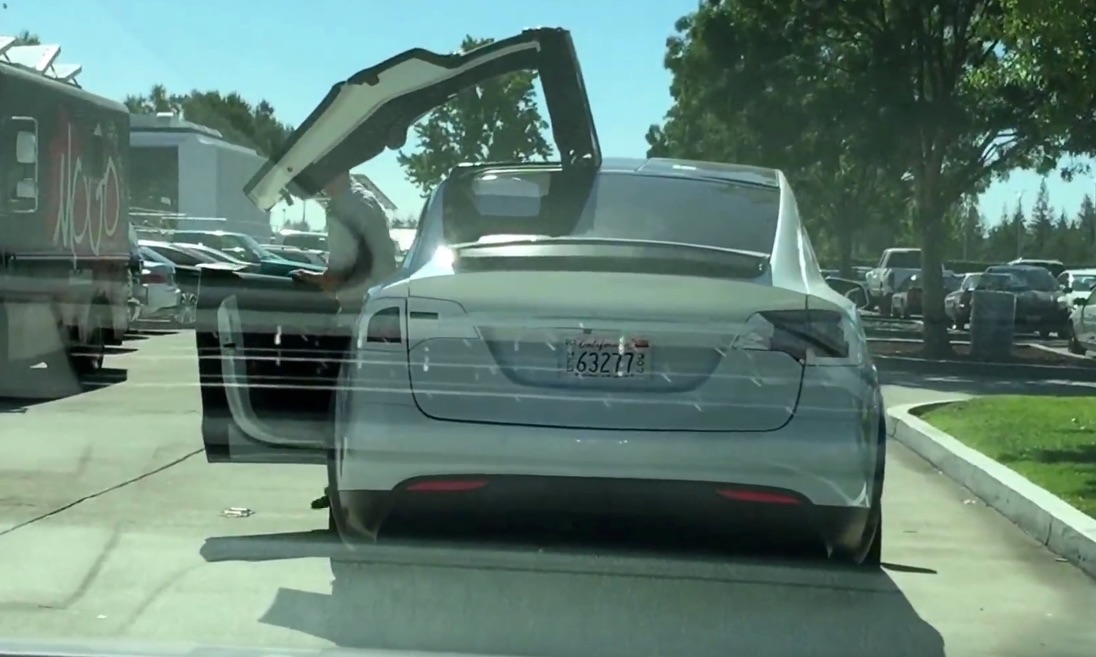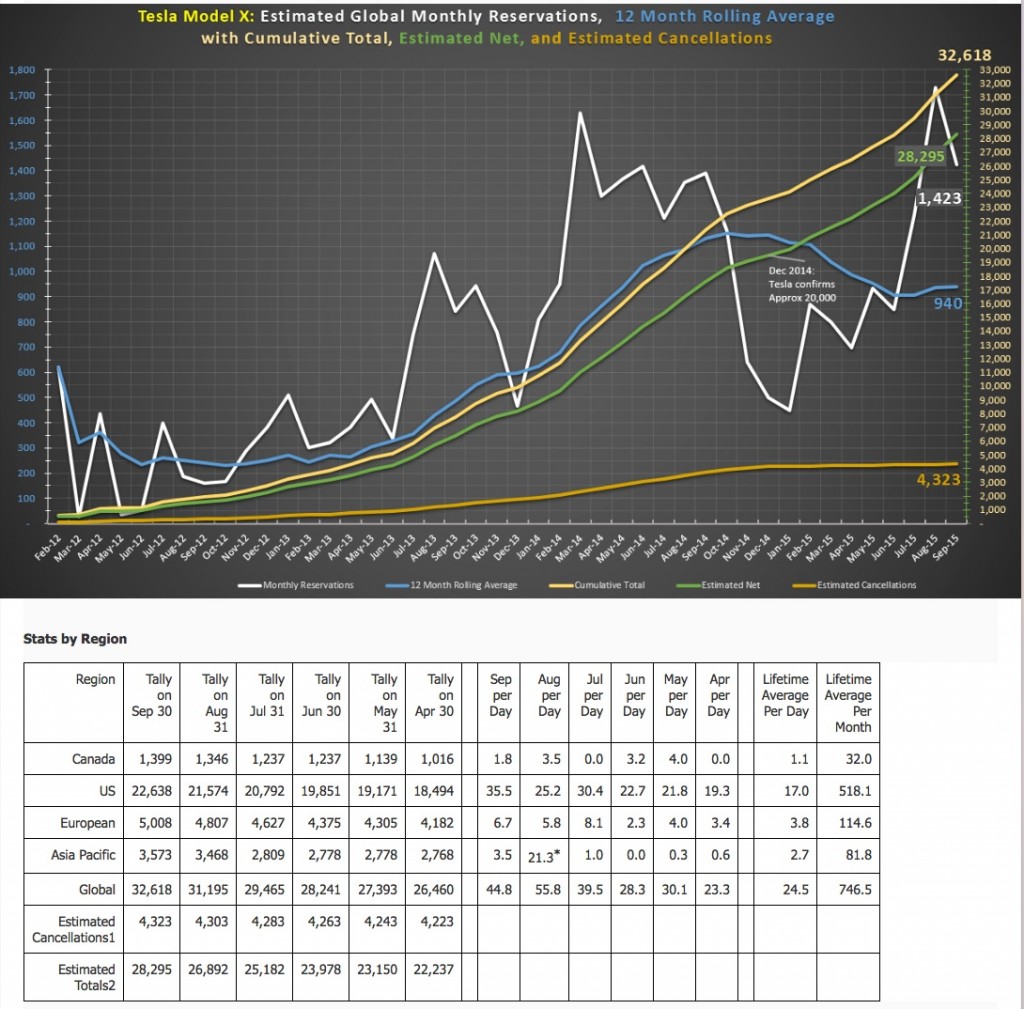News
Tesla Model X Reservations Reach All Time High in September
Model X reservations have reached a net of more than 28,000 units according to ModelXTracker.com. A tweet by Elon about a possible Model Y has been deleted.

The rate of Model X reservations in the US reached an all time high of 35.5 reservations per day (44.8 orders per day on a global scale) following the recent Model X launch event according to Paul Carter, TMC member and founder of ModelXTracker.com.
While Tesla has been slow on providing specific details on the Model X, there’s been no shortage of reservations likely boosted by media frenzy surrounding the electric crossover’s trademark falcon wing doors, and their unique ability to pivot open while sandwiched between two cars.
We asked Paul about his thoughts on Model X adoption across the world and this is what he had to say. “Europe continues to grow by around 5% per month. Globally, the trend is heading in a similar direction, albeit at a slower pace than the two larger USA and Europe markets. Over the past year we’ve seen the global average move from 21.1 reservations per day to 24.5 per day. At this pace the rolling annual average might break its record in mere months from now”, says Paul.

Approximately 1,423 new reservations in September 2015 as Model X Tally reaches 32,618 with 28,295 Estimated Total (net of cancellations)1,2 [Source Paul Carter via TMC]
If we were to extrapolate global Model X reservations over the next quarter based on the current growth rate, it’s quite possible that we’ll see close to 40,000 non-adjusted Model X orders by year end. With such a high ramp up in Model X reservations, each requiring a $5,000 deposit, while being production constrained – Tesla seems to be following a similar trajectory that the Model S once had when it first launched.
Paul notes, “This is going to be very interesting to watch over the next quarter. Now that the Tesla Model X has been revealed and details are becoming available and a few deliveries are out of the way, I would expect rates and orders to pour in like they are for the Model S. In some markets for SUV lovers its likely to even surpass that demand in quick order.”
Footnotes:
1. Estimated 19,500 net reservations as of Dec 31, 2014 as per Q4 report of having “almost 20,000” on the books. Result:19,500 out of 23,643 = ~ 17.52% up to this date are likely cancelled.
2. Estimated Cancellations after December 31, 2014, currently estimated at 20/month
![Approximately 1,423 new reservations in September 2015 as Model X Tally reaches 32,618 with 28,295 Estimated Total (net of cancellations)1,2 [Source Paul Carter via TMC]](http://www.teslarati.com/wp-content/uploads/2015/10/Model-X-Daily-Reservations-Chart.jpg)
Model X News
- Thoughts on the Model X from a Model S owner
- First look at the Model X Firmware 7.0 features
- What does the Model X ‘Bio Weapon Defense Mode‘ do?
- First test drives and reviews of the Tesla Model X

News
Tesla starts showing how FSD will change lives in Europe
Local officials tested the system on narrow country roads and were impressed by FSD’s smooth, human-like driving, with some calling the service a game-changer for everyday life in areas that are far from urban centers.

Tesla has launched Europe’s first public shuttle service using Full Self-Driving (Supervised) in the rural Eifelkreis Bitburg-Prüm region of Germany, demonstrating how the technology can restore independence and mobility for people who struggle with limited transport options.
Local officials tested the system on narrow country roads and were impressed by FSD’s smooth, human-like driving, with some calling the service a game-changer for everyday life in areas that are far from urban centers.
Officials see real impact on rural residents
Arzfeld Mayor Johannes Kuhl and District Administrator Andreas Kruppert personally tested the Tesla shuttle service. This allowed them to see just how well FSD navigated winding lanes and rural roads confidently. Kruppert said, “Autonomous driving sounds like science fiction to many, but we simply see here that it works totally well in rural regions too.” Kuhl, for his part, also noted that FSD “feels like a very experienced driver.”
The pilot complements the area’s “Citizen Bus” program, which provides on-demand rides for elderly residents who can no longer drive themselves. Tesla Europe shared a video of a demonstration of the service, highlighting how FSD gives people their freedom back, even in places where public transport is not as prevalent.
What the Ministry for Economic Affairs and Transport says
Rhineland-Palatinate’s Minister Daniela Schmitt supported the project, praising the collaboration that made this “first of its kind in Europe” possible. As per the ministry, the rural rollout for the service shows FSD’s potential beyond major cities, and it delivers tangible benefits like grocery runs, doctor visits, and social connections for isolated residents.
“Reliable and flexible mobility is especially vital in rural areas. With the launch of a shuttle service using self-driving vehicles (FSD supervised) by Tesla in the Eifelkreis Bitburg-Prüm, an innovative pilot project is now getting underway that complements local community bus services. It is the first project of its kind in Europe.
“The result is a real gain for rural mobility: greater accessibility, more flexibility and tangible benefits for everyday life. A strong signal for innovation, cooperation and future-oriented mobility beyond urban centers,” the ministry wrote in a LinkedIn post.
News
Tesla China quietly posts Robotaxi-related job listing
Tesla China is currently seeking a Low Voltage Electrical Engineer to work on circuit board design for the company’s autonomous vehicles.

Tesla has posted a new job listing in Shanghai explicitly tied to its Robotaxi program, fueling speculation that the company is preparing to launch its dedicated autonomous ride-hailing service in China.
As noted in the listing, Tesla China is currently seeking a Low Voltage Electrical Engineer to work on circuit board design for the company’s autonomous vehicles.
Robotaxi-specific role
The listing, which was shared on social media platform X by industry watcher @tslaming, suggested that Tesla China is looking to fill the role urgently. The job listing itself specifically mentions that the person hired for the role will be working on the Low Voltage Hardware team, which would design the circuit boards that would serve as the nervous system of the Robotaxi.
Key tasks for the role, as indicated in the job listing, include collaboration with PCB layout, firmware, mechanical, program management, and validation teams, among other responsibilities. The role is based in Shanghai.
China Robotaxi launch
China represents a massive potential market for robotaxis, with its dense urban centers and supportive policies in select cities. Tesla has limited permission to roll out FSD in the country, though despite this, its vehicles have been hailed as among the best in the market when it comes to autonomous features. So far, at least, it appears that China supports Tesla’s FSD and Robotaxi rollout.
This was hinted at in November, when Tesla brought the Cybercab to the 8th China International Import Expo (CIIE) in Shanghai, marking the first time that the autonomous two-seater was brought to the Asia-Pacific region. The vehicle, despite not having a release date in China, received a significant amount of interest among the event’s attendees.
Elon Musk
Elon Musk and Tesla AI Director share insights after empty driver seat Robotaxi rides
The executives’ unoccupied tests hint at the rapid progress of Tesla’s unsupervised Robotaxi efforts.

Tesla CEO Elon Musk and AI Director Ashok Elluswamy celebrated Christmas Eve by sharing personal experiences with Robotaxi vehicles that had no safety monitor or occupant in the driver’s seat. Musk described the system’s “perfect driving” around Austin, while Elluswamy posted video from the back seat, calling it “an amazing experience.”
The executives’ unoccupied tests hint at the rapid progress of Tesla’s unsupervised Robotaxi efforts.
Elon and Ashok’s firsthand Robotaxi insights
Prior to Musk and the Tesla AI Director’s posts, sightings of unmanned Teslas navigating public roads were widely shared on social media. One such vehicle was spotted in Austin, Texas, which Elon Musk acknowleged by stating that “Testing is underway with no occupants in the car.”
Based on his Christmas Eve post, Musk seemed to have tested an unmanned Tesla himself. “A Tesla with no safety monitor in the car and me sitting in the passenger seat took me all around Austin on Sunday with perfect driving,” Musk wrote in his post.
Elluswamy responded with a 2-minute video showing himself in the rear of an unmanned Tesla. The video featured the vehicle’s empty front seats, as well as its smooth handling through real-world traffic. He captioned his video with the words, “It’s an amazing experience!”
Towards Unsupervised operations
During an xAI Hackathon earlier this month, Elon Musk mentioned that Tesla owed be removing Safety Monitors from its Robotaxis in Austin in just three weeks. “Unsupervised is pretty much solved at this point. So there will be Tesla Robotaxis operating in Austin with no one in them. Not even anyone in the passenger seat in about three weeks,” he said. Musk echoed similar estimates at the 2025 Annual Shareholder Meeting and the Q3 2025 earnings call.
Considering the insights that were posted Musk and Elluswamy, it does appear that Tesla is working hard towards operating its Robotaxis with no safety monitors. This is quite impressive considering that the service was launched just earlier this year.








